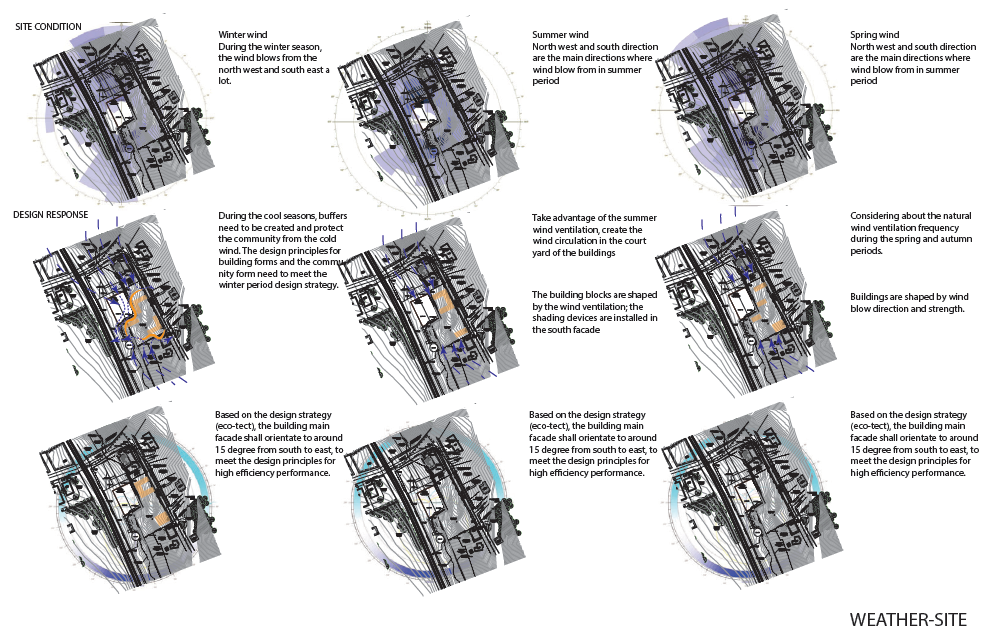Development & Investment Decision Making Strategies on Private Property III
Architectural Programming
Driven by big data techniques, the developers or owners are able to get the basic design feature information and suggestions from the third party during the market feasibility analysis. There shall be a bridge that connects the feasibility analysis results (output) and the design forces (input), and the strategy of architectural programming is most likely to be involved in this condition. Based on the standard AIA agreements, programming is normally in charge by the owner and developer, however, in some cases, the owner may not able to develop the program and must use the services of a programming consultant. As the research and decision-making process, architectural programming explores the issues which need to be solved by design. The entire process embodies the research process to collect, analyze, and document relevant information and draw a conclusion, in the meanwhile, the method establishes the appropriate criteria for the design solutions.
Generally, there are fourteen steps for typical architectural programming:
1, Program form 2, Program content 3, Preliminaries 4, Executive summary 5, Values and goals 6, Design considerations 7, Project requirements 8, Space identification and allocation 9, Relationship matrices and diagrams 10, Space program sheet 11, Budget and cost analysis 12, Project schedule 13, Design analysis 14, Appendix (6)(9)
Architectural programming systematically contributes to the informational system of the entire project design-built process, and each stage in the programming has a branch of sub-strategies and analysis tools. For instance, from step 5 to step 7, the developer may integrate the information from the market analysis results, which allocate each type of market trend for the project. Generally, the data source for market analysis may be contributed by the third parties of real estate professions, like the real estate transaction agencies, home builders, the brokers, and realtors, and enormous data from online credits and records. The market analyzers need to take advantage of big data research tools on the data pools, and build the mathematical model on the demographic-property feature-finance trends and facts structures, and this is the reason why the developer shall not rely on the architects or contractors consults in this strategy. Once a target product is roughly determined, the architects and facility designers may assist the developer full fill those steps in programming.
The following network diagram clarifies out the functions and relationship structure of each assigned constant and variable component for an eight-unit urban dwell project. Similar to the general visual computer programming platform, this program allows users to easily build numbers of structural models by moving, connecting, or disconnecting, building, or deleting the components. In this example, there are more than ten types of modeling components, which are identified by different colors or shapes. The following diagram also presents the structure of the CRS analysis model, which is an architectural programming tool based on a matrix system introduced last century. CRS encourages decision-maker evaluation of the valuable design elements by researching design goals, performance requirements, and design requirements hierarchically and tightly.
Fig. The eight-unit residential property design programming demonstrates the master plan to highly detailed interior finishing logic structure and relationship, modeled and arranged by the author
Fig. San Francisco city zoning search system, the left window presents the zoning control table and codes, and the top right window demonstrates the detail information and data for a specific lot, and the downright window shows the high detail sky view for the neighborhood with topography and lot number, powered by American Legal Publishing Corporation
Fig. Demographic analysis of a mixed-use residential project in Asheville, RAD neighborhood renovation, based on the statistic technique and data collection, Nc, analyzed by the author
Fig. a typical workflow principle-program demonstrates the data-based decision making programming strategy, modeled and arranged by the author
Life Cost Analysis Method
As a developer or speculator, it is essential to understand and estimate the life cycle cost of a property, whether it is unbuilt land or existing property. According to Whole Building Design Guides (WBDC), a program of the National Institute of Building Sciences (United States), “a method for assessing the total cost of facility ownership. It takes into account all the costs of acquiring, owning, and disposing of a building or building system.”(4) Here is the equation for LLC method:
LCC = I + Repl – Res + E + W + OM&R + O
LCC = Total LCC in present-value (PV) dollars of a given alternative
I = PV investment costs (if incurred at base date, they need not be discounted)
Repl = PV capital replacement costs
Res = PV residual value (resale value, salvage value) less disposal costs
E = PV of energy costs
W = PV of water costs
OM&R = PV of non-fuel operating, maintenance and repair costs
O = PV of other costs (e.g., contract costs for ESPCs or UESCs)
Another important estimate tool for architecture life cycle analysis is the LCA method. According to International Standard ISO 14040, LCA is a “compilation and evaluation of the inputs, outputs and the potential environmental impacts of a product system throughout its life cycle.” As a building design and development estimating tool, LCA “allows architects and other building professionals to understand the energy use and other environmental impacts associated with all life cycle phases of the building: procurement, construction, operation, and decommissioning.”(5)
Financial Analysis Strategies
This section will continue to argue some of the most essential decision-making strategies of the finance aspects among the entire single-family residence speculating activity, and drill down to the bottom line for maximizing profit and minimize risks. The investor’s biggest challenge is to identify the highest and best use of the property and land value. For the developers, the general financial analysis embodies the following techniques and methods which occupy quite significant roles in the early development stages. On the other hand, the financial analysis is quite essential for the property owners who need to get a loan to restore their properties, and the process usually is undertaken by the appraiser and the accountant, who would present the future sales price report and development cash flow report to the loan agency for re-construction the existing property(7).
Take a brief look at the views from the house investors, which may drive more deeply in a specific situation in the decision-making process. When the investor already purchased the property years ago and he wants to get a loan from the bank since he plans to get a higher price for the sale. A project development business plan needs to be prepared for the property reconstruction loan, which normally contains the content of appraising reports, costs to remodel the property, profit, and loss forecast for remodeling, and project development cash flow forecast.
Normally, there are five stages of financial analysis for project development. Stage one applies the simple capitalization of pro-foma NOI, which demonstrates the rental and sales revenue summary and contributes a pro-foma statement that estimates the stabilized project rents and expenses. In stage two will present the discounted cash flow (DCF) analysis of annual cash flows during stabilized cash flows of the operating period, which is considered the most essential section of the entire financial analysis. The combined analysis of the development and operating and the monthly cash flows during the development periods are applied by stage three and stage four, and the final stage justifies DCF analysis for investors.
Any owners/investors need their budget to track how the project is developed, constructed, and operated. In the owner’s budget analysis, the owner could track and examine each category within the whole project development. There are three main sections in the owner’s budget analysis: construction costs, project costs, and life-cycle costs. The owner is able to understand the appropriate costs embodied in each category during the entire project development. Some second-hand property investors might ignore the history of operation, performance, or energy records of the property, and all these embody costs are called life-cycle costs which occupy a large scale of the entire costs. For specific, appraisers normally can apply the income approach to find out the value of the property by calculating the NOI and capitalization rate. Cap-rate can be found by comparison between other properties, calculating by the price they were sold and their NOI per year. Here are some equations which identify the relationship between the effective gross income (EGI), operating costs, cap rate, and NOI(8):
Effective gross income minus operating expenses equals NOI,
Effective gross income equals the potential gross income minus vacancy and collection loss.
NOI divided by cap rate equals the property value
A widely used rental property operating expense and income tracking schedule is called the NOI(Net Operating Income) table, which is similar to the IRS 1040 schedule E. Net operating income equals all revenue from the rental property (Effective Gross Income) minus all reasonably operating expenses. Take an example for schedule E in order to make a better summary of the property’s annual operating expense and overall income. The owner needs to take record some essential costs on the daily or monthly general expense, liability, or any other fees relative to the rental property, which are itemized as the cleaning/maintenance, repair, insurance, mortgage interests, real estate tax, supplies, depreciation, utilities. Usually, the amount of depreciation is relative to the date with the property costs, any newly installed fixtures, and facilities, and property restoration costs. The NOI is key evidence for property appraising, purchase, and development loan application, and architectural life cost analysis. Usually, NOI appears on the property’s income and cash flow statements.
Notes
(1) Madurika H and Hemakumara G. (2015) Gis Based Analysis For Suitability Location Finding In The Residential Development Areas Of Greater Matara Region. International Journal of Scientific & Technology Research 4: 96-105.
(2) Saaty, Thomas L. (June 2008). “Relative Measurement and its Generalization in Decision Making: Why Pairwise Comparisons are Central in Mathematics for the Measurement of Intangible Factors – The Analytic Hierarchy/Network Process” (PDF). Review of the Royal Academy of Exact, Physical and Natural Sciences, Series A: Mathematics (RACSAM). 102 (2): 251–318. doi:10.1007/bf03191825. Retrieved 2008-12-22.
(3)Autodesk Sustainability Workshop https://sustainabilityworkshop.autodesk.com/building-design/concepts
(4)Life Cycle Cost Analysis, Wold Building Design Guide, by the National Institute of Building Science, https://www.wbdg.org/resources/life-cycle-cost-analysis-lcca
(5)AIA Guide to Building Life Cycle Assessment in Practicehttps://www.brikbase.org/sites/default/files/aiab082942.pdf
(6)Yasser Osman Moharam Mahgoub, Architectural Professional Practice-Programming, https://www.slideshare.net/ymahgoub/architectural-professional-practice-programming?qid=7f2288bf-1b75-49d6-a5dc-406e04541428&v=&b=&from_search=1
(7)Richard Peiser and David Hamilton, Professional Real Estate Development: The ULI Guide to the Business, 3rd Edition. see Chapter 3
(8)Ventolo, William L., and Martha R. Williams. Fundamentals of Real Estate Appraisal. La Crosse, WI: DF Institute, Inc, D/b/a Dearborn Real Estate Education, 2015. see Chapter of Capitalization Approach
(9)According to WBDG, architectural programming contains the following six steps:
1. Research the project type, 2. Establish goals and objectives, 3. Gather relevant information, 4. Identify strategies, 5. Determine quantitative requirements, 6. Summarize the program. According to Architectural Programming and Predesign Manager by Robert G. Hershberger, there are three main methods for the decision making and evaluation 1, Investigation &Research, 2, Qualitative Judgment, 3, Quantitative Judgment





